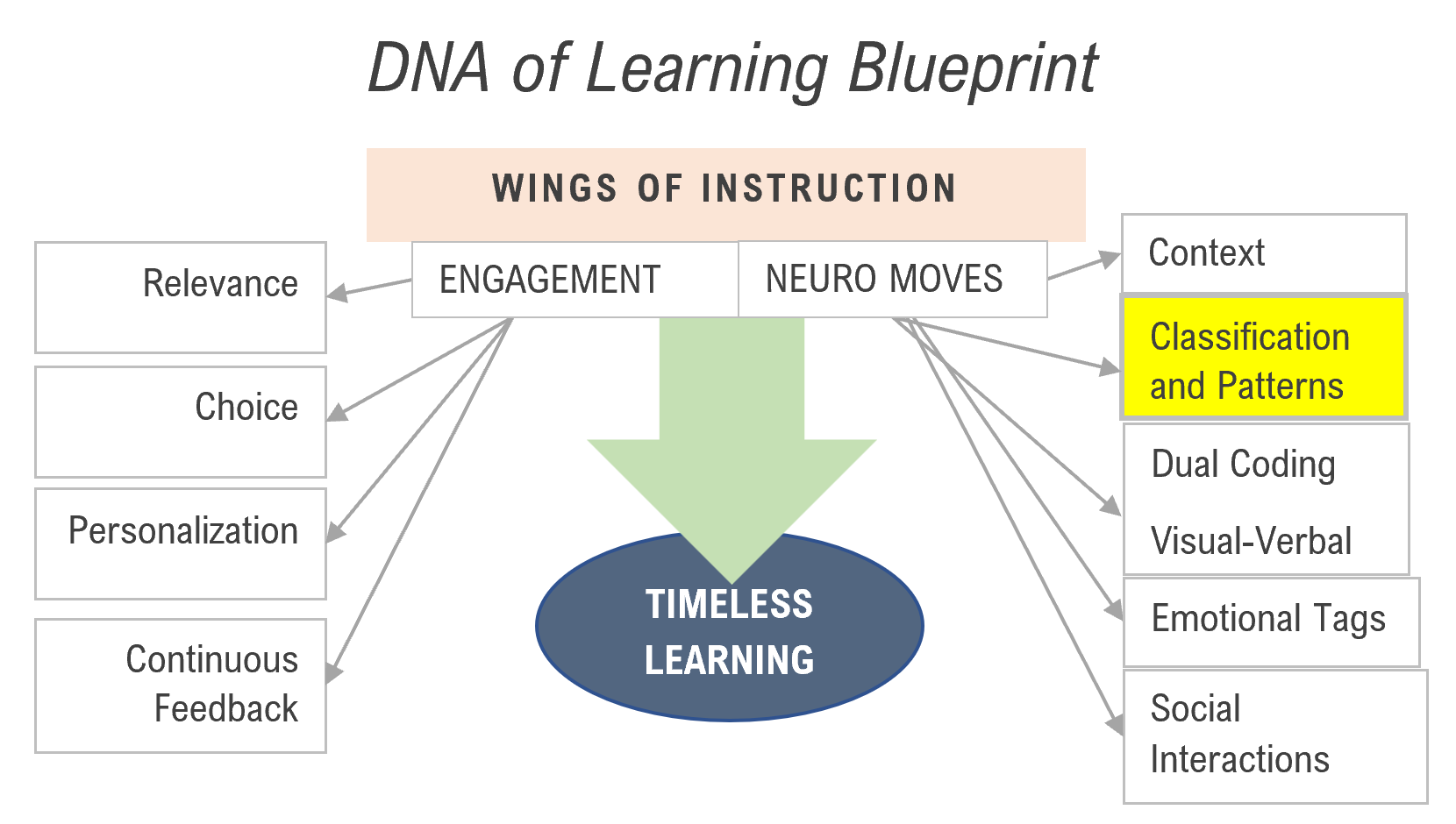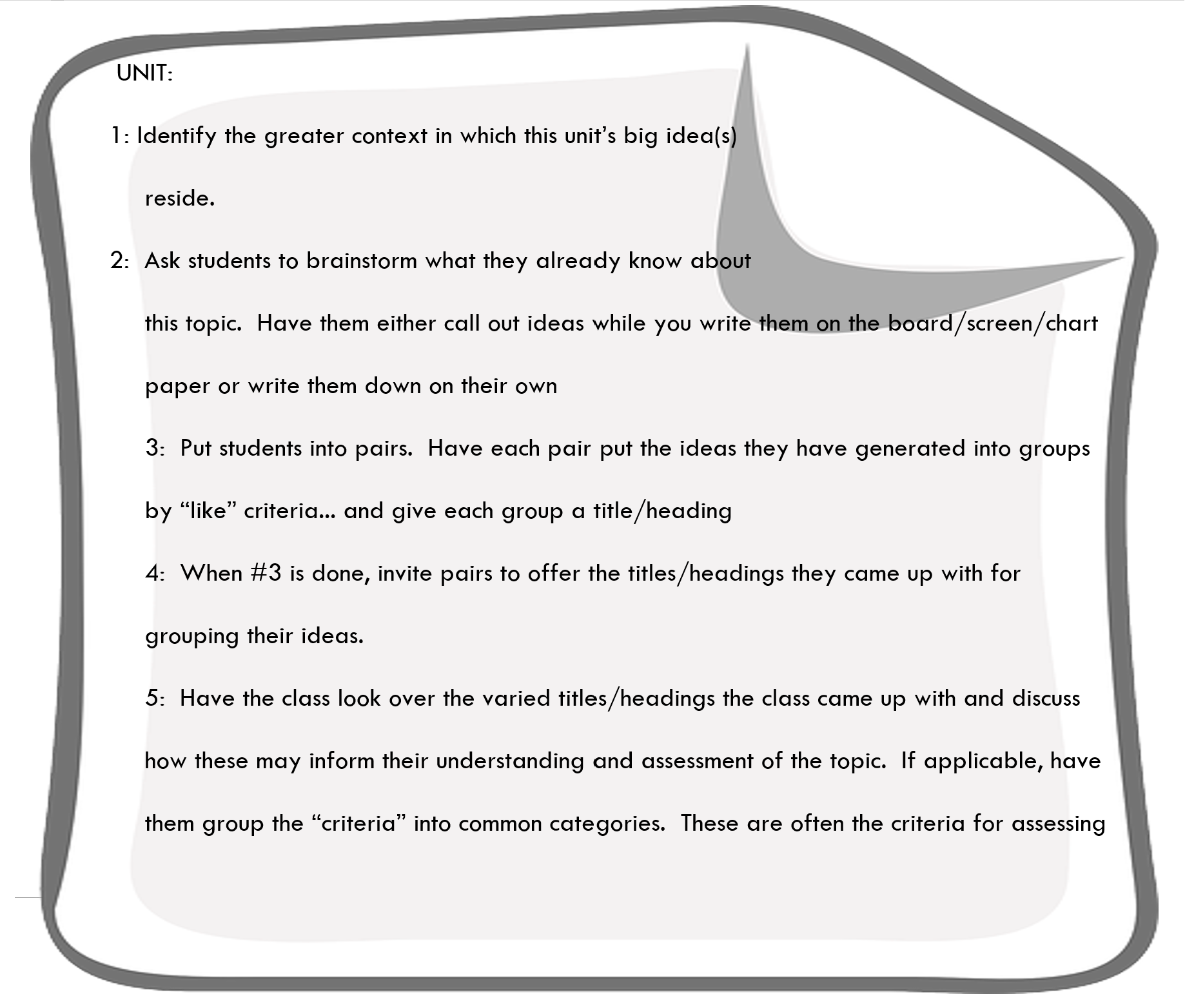
The Wings of Instruction: Neuro-Move #2 – CLASSIFICATION
When Teaching Mirrors Learning Series
Unpacking The DNA of Learning Blueprint
©2023
Each article in this 15 part series systematically unpacks the DNA of Learning Blueprint for kindling the spirit of learning and re-starting our passion as educators. The collective series will represent a comprehensive outline of fundamental requirements for timeless learning across ages and disciplines.
Part 9: The Wings of Instruction: Neuro-Move #2 – CLASSIFICATION
Classification’s Role in DNA’s “wings OF INSTRUCTION”
Joe, a 5th grade science teacher, gathered his students around the large community table to begin a unit. This had become standard practice for the start of all new learning. This unit was about mammals. Following the DNA of Learning, Joe knew that engaging student’s thinking about the content and concepts to be taught was the first, most critical step to successful teaching. The kids thoroughly enjoyed the opportunity to talk about what they knew, and the initial activity in the process was to provide a greater context for the unit’s focus. “Let’s start with a brainstorm session and think about different animal types as the overall “context” of animals in general. I’ll record all your thinking on this whiteboard.” Cows, birds, snakes, fish, lobsters, spiders and even dinosaurs were among the many. It was an impressive collage of prior knowledge. All could participate, regardless of varied reading levels, experiences and other factors present with most groups of students. “First, with your partner, place items into groups—any grouping that make sense to you. There is no right or wrong answer right now. Next, title each group, using your own language, that also makes sense to you.”
Without direct instruction, they were classifying! Forming such groupings such as air/water/land, 0-2-4-6-or 8-legged, meat vs. plant, vertebrates, exoskeletal, fur vs. hair, house pet vs. farm, deadly vs. safe, fast vs. slow and more. The discussion of similar and different attributes leads to identifying the work focus ahead. Students were engaged, sharing, personalizing their understandings, and forming a greater context for their work prior to focusing on the direct instruction and the assignment.
Do you suppose…
…that if students were given the opportunity to sort information according to any category that has meaning or personal interest, they would better connect with prior experiences, identify purpose, and be more willing to further explore the learning new things? Certainly, when any of us relate through our prior knowledge or experience, we immediately are engaged and have an initial connection. From this, we are more open to explore and discover emerging ideas and understandings.
What is Classification?
From birth, the brain encounters the world seeking meaning. When we do not recognize what we are experiencing, the brain instinctively will seek patterns in an attempt to identify common attributes that provide structure or meaning. Early on, to make sense of what we experience through our senses, we first look for that which may be familiar to us, similar enough to be grouped with something we know. We also seek to notice what distinguishes one item from another. If we ask 3–5-year-old children to work with objects differing in color, shape, and size, they quickly sort them into “like” groups—initially by color. Instinctively, the mind sorts to make sense of it all. We compare/contrast new inputs with familiar ones as understandings evolve into a more apparent, comprehensive, greater depth. Patterning and grouping with criteria are fundamental to processing and continues through all ages and levels of sophistication.
Classification’s Role in DNA’s “WINGS” of Instruction

Unpacking Classification
From infants right up through higher education the practice of classifying begins with sorting, grouping, and organizing (Marzano, 2019). These become increasingly discrete depths of understanding, as we become more sophisticated in our learning, with concepts such as pros/cons, debate, and argument. Classification may evolve as follows:
- Early learners quickly sort objects by color, putting all the red pieces together, then grouping blue, then yellow and so forth
- Early readers gravitate to a certain author, genres, or topics of interest (dinosaurs, planets, etc.).
- Young students in science class place animals and plants into species—one of seven categories in their respective kingdoms that have attributes in common that inform understanding
- Adolescent learners develop patterns that have similarities and differences among people, cultures, governments, countries, and eras in history. These are rich with classifications that bring clarity to discussion and perspective, and are readily applied right through current, relevant times.
- Adult learners such as economists use familiar cycles of cause/effect and circumstance to predict upcoming trends. Physicians seek to identify common symptoms toward making a diagnosis. Teachers guide next steps with consideration of prior outcomes and patterns of behavior and outcomes.
The human mind sorts and classifies to identify patterns, form greater understanding, and make decisions. Aligning instructional practices with something the brain already does naturally is a “no-brainer.”
Schooling
Classification is fundamental for attention in all disciplines. When initial content components are abstract or otherwise meaningless (like letter or number configurations, CVC word patterns, 1s-10s-100s in each 3-digit period segment of numbers, and letter-sound associations the mind seeks meaning through patterns). As learning progresses, classification evolves meaningless letters into sounds and words of interest that contain meaning and abstract number symbols become related to known values. Venn-diagrams, sorting, pro/con, organizing criteria into a set/group, and representing information with mind-maps becomes more sophisticated as we hone critical thinking.
New information is often a barrage of input requiring determination of importance… “Why does this matter? Is it worth doing?” With new learning, the brain attends for about 15 seconds attempting to
determine meaning or connection. Patterns help sustain attention as we search of meaning. Without meaning the brain merely holds information in short-term memory–long enough for an upcoming quiz or paper, and with that done the information becomes less important. With less perceived value there’s less interest. As interest wanes synaptic connections in the brain diminish, decrease and “forgetting” takes place.
What if…
…before studying the Crusades, the American Revolution, WWI, WWII, or the Russian/Ukraine war in a high school social studies class, we first discuss the big idea, the purpose and intent of studying history first? Perhaps framing the learning through the lens of conflict would tap into personal meaning for learners, as they relate varied forms and expressions of conflict across global, country, community, family and even personal issues… all embedding in current events at times!
Ms. Becker’s Framing of a Big Idea: Conflict
Ms. Becker read a piece from the local news about factions of the community convening to discuss a proposed re-routing of traffic through the town. People were up in arms; some even threatening court actions. She asked the class, “to pause, think, and to “quick write”, some reasons why the people were at odds with one another. After some volunteered feedback, Ms. Becker, knowing that relevance and personalized learning is key to understanding, asked the class what other disputes and conflicts they knew about such as: family and household differences; local politics: state, federal and world challenges. After brief brainstorming and discussion, she began using “classification” to help students develop deeper, critical thinking skills to understand the concept of conflicts. She queried: “What are the common or unique causes of such conflicts? Why do some conflicts result in court cases, some in neighborhood feuds and some in outright war while others are resolved more peacefully?” Again, the class enthusiastically chimed in, noting disputes and conflicts in every corner of life, some personal, some political, and so on. Now vested, Ms. Becker posed some new thinking around the notion of conflict. “Are there criteria that might help us understand the origins, conditions, and circumstances of local and world conflicts throughout all ages? Are some economically based? Culturally based? Religiously based? Socially based? Other? What precipitates varied levels of conflict?
Mrs. Baker realized overall understanding improved as students learned to classify conflicts into types, levels, or other categories, prior to unpacking any specific one. She realized that context and classification mattered to learning! Once the class had a grasp of the big idea behind studying conflicts and wars through the ages, the students generated greater learning while they encountered understanding of the facts and information regarding such current, local and historical events.
Reclassifying
Once we classify to build meaning, extension activities can deepen our understanding. Our first patterns and groupings are typically based on prior knowledge and experience. If we look again at the same inputs, we will discover other possibilities for organizing the same information. This is reclassifying! For example, four of us were padding our kayaks around the lake. A little boy was watching us go by and said, “You have two red kayaks and two green kayaks.” You’re right!” I said. We chatted a bit and I asked, “Is there another way to describe them?” He replied, “Yes. Two are longer(green) and two are shorter(red).” Again, I concurred and further pushed for yet another way to group them. This time he pondered, then said, “Well, yes. Two have women in them and two have men, however they are not the same color or the same length.” In short order, the boy had classified first by color first, then by length and finally by the gender of the person paddling the craft. His flexibility in shifting criteria for inclusion in alternative groupings was impressive!
Beyond our initial choices and sorting, we can expand our thinking by reviewing initial perceptions and reclassifying using a different set of criteria. After initial comparisons, revisiting our work provides significant processing for understanding across additional venues, in multiple ways. The capacity for a learner to re-work recent learning and transfer it to aligned or even non-related areas engages extended understandings to deeper levels. To support this development, the fourth principle of engagement, continuous feedback, can guide learners to apply their newfound thinking across varied personal interests. This iterative loop of feedback can cause perseverance needed to generate meaning and lasting memory.
Moving toward tomorrow
Step 1: When planning your lesson, first consider providing a relevant context for students to access prior knowledge. Using classification strategies allows students to explore and notice similarities and differences
Step 2: Consider how students will apply the natural tendency of comparing/contrasting things. The brain automatically surveys how things are similar or different through prior knowledge and experiences, causing the mind to associate relevant information and understandings—increasing meaning and memory
Step 3: Have students identify criteria used within/for groupings of information. Ask them to organize the terms/ideas into clusters that make sense to them (alone or in pairs). Have them write a word to describe each cluster, then share these category titles with everyone
Step 4: Make note where learners will compare/contrast both within a topic, as well as across domains.
This is essential for application and for analogies that foster deeper, contextualized understanding
Step 5: Consider how students will share their initial and later learned (before/after) understandings of what is transferable from their work to other areas?
As learners apply what is already available to them, they will develop confidence navigating uncertainties, and feel more comfortable venturing into new learning territory. Locating patterns, classifying like and unlike things and generating comparisons helps serve the brain’s memory requirements for strengthening connections. Classifying leads to organization, problem solving, relationship building, and transfer of knowledge. Once the psychology of engaging a learning mindset occurs, then the biology of neuro-moves can complete the learning agenda!

their work later on. This is essential for application and analogies that foster deeper, contextualized understanding
Citations:
Marzano, Robert. 2019. “Marzano’s 9 Instructional Strategies For Teaching And Learning” https://www.teachthought.com/learning/instructional-strategies/